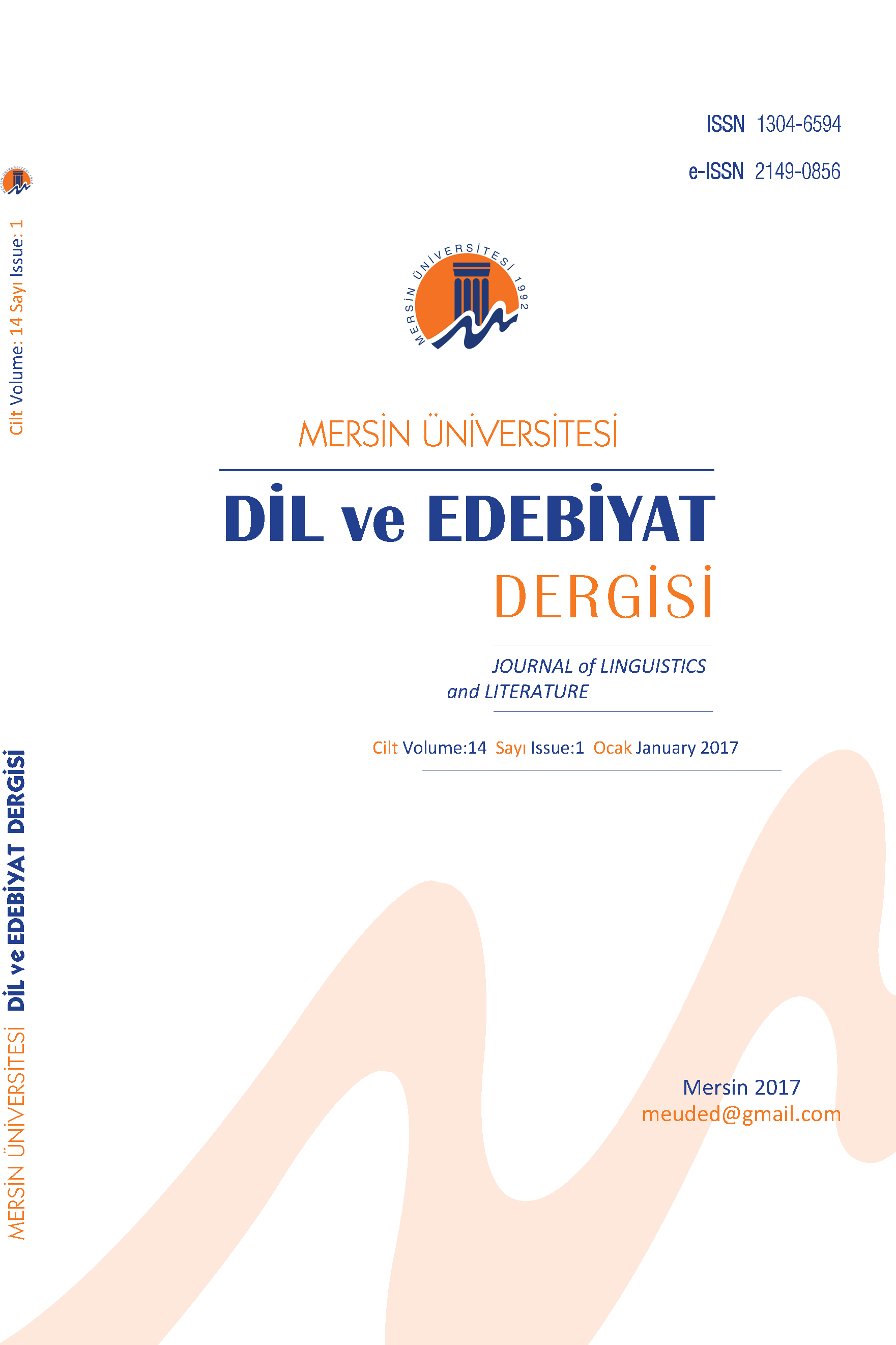Bakmak Eylemi ve Söylem İşlevleri: Eşdizimlilik Örüntülerinin Gösterdikleri
‘bakmak’ eylemi, söylem işaretleyicileri, Türkçe Ulusal Derlemi
The Verb Bak- ‘to look’ and its discourse functions: Corpus concordances
___
- Aikhenvald, A.Y. (2010). Imperatives and commands. Oxford: Oxford University Press.
- Aksan, Y. & Demirhan, U. U. (2015). Expressions of gratitude in the Turkish National Corpus. In Ş. Ruhi & Y. Aksan (Eds.), Exploring (Im)politeness in Specialized and General Corpora: Converging Methodologies and Analytic Procedures (pp. 121-172). Newcastle: Cambridge Scholars Publishing.
- Aksan, Y., Aksan, M., Koltuksuz, A., Sezer, T., Mersinli, Ü., Demirhan, U. U., Yılmazer, H., Kurtoğlu, Ö., Atasoy, G., Öz, S., & Yıldız, İ. (2012). Construction of the Turkish National Corpus (TNC). In N. Calzolari, K. Choukri, T. Declerck et al. (Eds.), Proceedings of the 12th International Conference on Language Resources and Evaluation (LREC) (pp. 3223-3227). İstanbul, Turkey: LREC 2012.
- Aksan, Y., Aksan, M., Özel, S. A., Yılmazer, H., Demirhan, U. U., Mersinli, Ü., Bektaş, Y., & Altunay, S. (2016). Web tabanlı Türkçe Ulusal Derlemi (TUD). In M. Akgül, U. Çağlayan, E. Derman & A. Özgit (Eds.), Proceedings of the 16th Academic Computing Conference (pp. 723-730). İstanbul: Gamze Yayıncılık.
- Brinton, L. (2001) From matrix clause to pragmatic marker. Journal of Historical Linguistics, 2(2), 177-199.
- Dobric, N. (2015). Three-factor prototypicality evaluation and the verb look. Language Sciences, 50, 1-11.
- Gisborne, N. (2010). The event structure of perception verbs. Oxford: Oxford University Press.
- Hardie, A. (2013). CQPweb — combining power, flexibility and usability in a corpus analysis tool. International Journal of Corpus Linguistics, 17(3), 380-409.
- Hoffman, S., Evert, S., Smith, N., Lee, D., & Prytz, Y. B. (2008). Corpus linguistics with BNCweb – A practical guide. Frankfurt: Peter Lang.
- Jay, M. & M. Kissine (2014). Imperatives. Cambridge: Cambridge University Press.
- Kornfilt, J. (1997). Turkish. London: Routledge.
- König, E. & Siemund, P. (2007). Speech act distinctions in grammar, T. Shopen (Eds.) in Language Typology and Syntactic Description Second edition Volume I: Clause Structure, Cambridge: Cambridge University Press, 276-324.
- Ruhi, Ş. (2011). LOOK as an expression of procedural meaning in directives in Turkish: Evidence from the Spoken Turkish Corpus. Paper presented at 6th International Symposium on Politeness, 11-13 July, 2011, METU.
- Stefanowitch, A. & Gries, S. (2003). Collostructions: Investigating the interaction of words and constructions. International Journal of Corpus Linguistics 8(2): 209–243.
- Sweester, E. (1991). From etymology to pragmatics. Metaphorical and cultural aspects of semantic structure. Cambridge: Cambridge University Press.
- Takahashi, H. (2010). A cognitive analysis of the English imperative. Amsterdam: John Benjamins.
- Viberg, A. (1984). The verbs of perception: A typological study. In Explorations for Language Universals, B. Butterworth, B. Comrie and O. Dahl (Eds.), 123–162. Berlin: Mouton de Gruyter.
- Viberg, A. (2001) Swedish verbs of perception from a typological and contrastive perspective. G. A. Gonzales & J.L. MacKenzie (Eds.) Languages and cultures in contrast and comparison. Amsterdam: John Benjamins, 123-172.
- ISSN: 1304-6594
- Yayın Aralığı: Yılda 2 Sayı
- Başlangıç: 2004
- Yayıncı: Mersin Üniversitesi
Derlem Dilbilimi Uygulamaları: Kuşaklararası Dayanışma Ölçeği Hazırlama
Güncel Biçimiyle Sözlü Türkçe Derlemi: Teknik ve İstatistiksel Bir Çözümleme
Sözlü Türkçe Derlemi ve Türkçe Ulusal Derleminde (U)lan'ın Edimbilimsel Bir İncelemesi
Hale IŞIK GÜLER, Betil ERÖZ-TUĞA
Bakmak Eylemi ve Söylem İşlevleri: Eşdizimlilik Örüntülerinin Gösterdikleri
Mustafa Aksan, Umut Ufuk Demirhan
Sözlü Türkçede Evet'in Görünümleri: Sözlü Türkçe Derlemi’nden Bulgular
